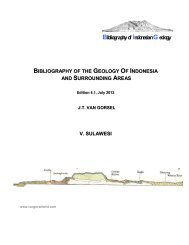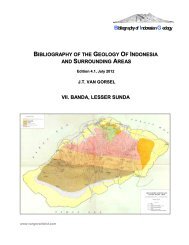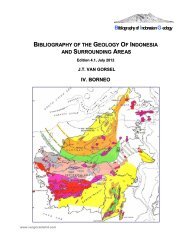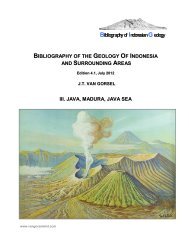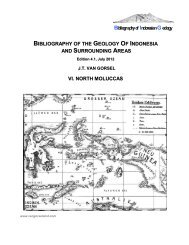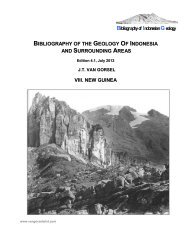Sumatra, Sunda Shelf, Natuna - Bibliography of Indonesia Geology
Sumatra, Sunda Shelf, Natuna - Bibliography of Indonesia Geology
Sumatra, Sunda Shelf, Natuna - Bibliography of Indonesia Geology
Create successful ePaper yourself
Turn your PDF publications into a flip-book with our unique Google optimized e-Paper software.
A widespread Plio-Pleistocene compressional event inverted many <strong>of</strong> the Paleogene rift normal<br />
faults, creating most <strong>of</strong> today's surface anticlines. The oblique subduction <strong>of</strong> the Indian Ocean plate<br />
under <strong>Sumatra</strong> gave rise to the major <strong>Sumatra</strong> Fault Zone, a NW-SE trending right-lateral strike slip<br />
fault zone across the Barisan Mountains volcanic arc. A similar, parallel fault zone, the Mentawai FZ<br />
is present in the <strong>of</strong>fshore and roughly parallels the front <strong>of</strong> the accretionary prism.<br />
<strong>Sumatra</strong> has long been an important hydrocarbon province, with all oil and gas production from the<br />
North, Central and South <strong>Sumatra</strong> 'back-arc' basins. Initial exploration in the late 1800's- early<br />
1900's focused on drilling surface anticlines, many <strong>of</strong> them with surface seeps, targeting the<br />
relatively shallow M-L Miocene sandstone reservoirs.<br />
A deeper play, and volumetrically the most important, is in Late Oligocene- basal Miocene fluvialdeltaic<br />
sandstones in anticlinal structures. It was discovered accidentally by drilling 'too deep' into<br />
the thick Early Miocene marine shale section over Christmas in 1922 at Talang Akar-Pendopo in S<br />
<strong>Sumatra</strong> (Talang Akar field in the Talang Akar Fm). The first discovery in the C <strong>Sumatra</strong> basin was<br />
in 1939 in the Lirik field and is also in this play. The largest fields oil fields in <strong>Sumatra</strong> are the giant 3-<br />
5 billion barrels Duri and Minas fields in C <strong>Sumatra</strong>, discovered in 1941 and 1944.<br />
A third play, which could not be explored in the old days <strong>of</strong> surface anticline mapping, is in E-M<br />
Miocene reefal carbonate buildups, and was a main focus <strong>of</strong> 1970's- 1980's exploration. The Arun<br />
field in N <strong>Sumatra</strong>, discovered in this play in 1971, is one <strong>of</strong> <strong>Indonesia</strong>'s largest gas fields.<br />
A fourth play, in fractured and weathered Pre-Tertiary basement, has generated interest since the<br />
mid-1980's, but volumes have been relatively minor.<br />
Suggested reading<br />
A recent major review <strong>of</strong> <strong>Sumatra</strong> geology is Barber, Crow & Milsom (2005)<br />
II.2. <strong>Sunda</strong> <strong>Shelf</strong> (incl. 'Tin Islands', Karimata)<br />
Some 150 papers are in the bibliography primarily on the <strong>Sunda</strong> <strong>Shelf</strong>, a broad shallow sea, that<br />
was exposed land during the Pleistocene glacial lowstands. A pattern <strong>of</strong> Pleistocene relict river<br />
channels draining from <strong>Sumatra</strong> and Borneo into the South China Sea was mapped by Molengraaff<br />
(1919), Hanebuth et al. (2000), etc.<br />
The <strong>Sunda</strong> <strong>Shelf</strong> forms the relatively stable core <strong>of</strong> '<strong>Sunda</strong>land', an area <strong>of</strong> relatively old continental<br />
terranes (Indochina- E Malaya- SW Borneo?), that amalgamated with Asia before the Permian. Pre-<br />
Tertiary rocks outcrop extensively, or are covered by only a thin veneer <strong>of</strong> fluvial and shelfal relict<br />
sediments.<br />
The main economic interest <strong>of</strong> the region is in the 'tin islands' Lingga, Singkep, Bangka and Belitung,<br />
<strong>of</strong>f the NE coast <strong>of</strong> <strong>Sumatra</strong>, probably extending to the Karimata islands <strong>of</strong>f SW Kalimantan. They<br />
are the S part <strong>of</strong> the SE Asian tin belt, which extends from N Burma, Thailand and W Malaysia.<br />
Mining has taken place since the early 1800's and <strong>Indonesia</strong> has produced ~15% <strong>of</strong> all tin mined in<br />
the world, mainly from alluvial cassiterite placer deposits eroded from Late Triassic granite<br />
intrusives. Today, reserves are largely depleted.<br />
<strong>Bibliography</strong> <strong>of</strong> <strong>Indonesia</strong> <strong>Geology</strong> v. 4.1 2 www.vangorselslist.com July 2012



